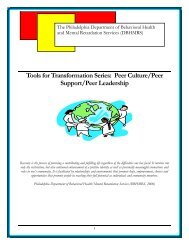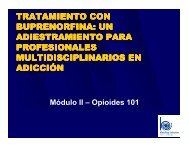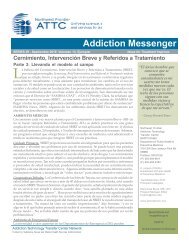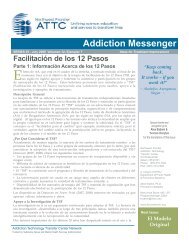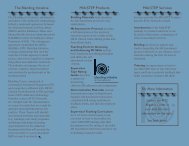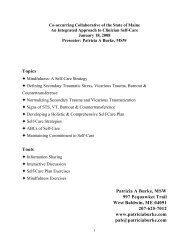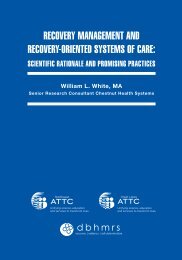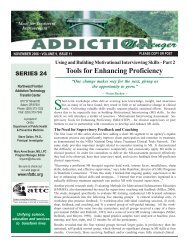alcohol and other drug problems among addiction professionals
alcohol and other drug problems among addiction professionals
alcohol and other drug problems among addiction professionals
Create successful ePaper yourself
Turn your PDF publications into a flip-book with our unique Google optimized e-Paper software.
◆◆◆◆One group noted a great deal of secrecy about issues of personal behavior<strong>among</strong> employees who have progressed into relapse patterns, contributing tothe hidden nature of these patterns. Sometimes an air of secrecy is one of thefirst signs of relapse.On an organizational level, the reporting of such incidents <strong>and</strong> their consequencesalso varies widely. The percentage of incidents resulting in disciplinarymeasures varies widely from organization to organization, depending on companypolicies. Even where the reporting of these incidents is m<strong>and</strong>ated, reportingis often inconsistent.In many cases, the term “relapse” lacks a consistent definition, with some definingit to include any recurrence of AOD use <strong>and</strong> <strong>other</strong>s reserving the wordfor return to problem use. This term can also be restricted to include only thereturn to AOD use per se, or be exp<strong>and</strong>ed to include the progression of dysfunctionalthought, feeling, urge, <strong>and</strong> behavior patterns that may or may notlead to return to use, sometimes known as “dry drunk” syndrome.Though they could not cite prevalence figures, some participants at the symposiumreported that they had seen many <strong>professionals</strong> with significant recoverytime descend into relapse patterns.It is not only the chronic <strong>and</strong> relapsing nature of the brain disease of <strong>addiction</strong>that contributes to the danger of recurrence <strong>among</strong> recovering <strong>professionals</strong> in thefield. It is also the over-stressed, under-funded, <strong>and</strong> under-resourced nature of the<strong>addiction</strong> treatment field as it has evolved.The primary impact of managed care has been a climate in which “doing more<strong>and</strong> more with less <strong>and</strong> less” is the consistent expectation. The stigma <strong>and</strong> resultingcriminalization of <strong>addiction</strong> have diverted possible resources away from peoplewith substance use disorders. Meanwhile, the depth <strong>and</strong> complexity of clients’needs, circumstances, <strong>and</strong> co-occurring disorders have increased exponentially.The <strong>addiction</strong> professional is suspended between a vast <strong>and</strong> growing need <strong>and</strong> asteadily dwindling resource base.Most people with the courage to remain in this difficult position will undergosome pressure to sacrifice their own well being for the greater good. Participantsnoted that many <strong>professionals</strong> in the field lack self-care <strong>and</strong> balance in their lives,often leading to compassion fatigue <strong>and</strong> burnout. The organizations themselvesseldom have structured programs or policies that encourage <strong>and</strong> support self-care.These factors both raise the level of turnover in the field <strong>and</strong> lead to progressivelevels of dysfunction in many of those who remain.Many sources of support that would mitigate these <strong>problems</strong> are also lacking.According to participants, many organizations lack formal employee assistance programs(EAPs), <strong>and</strong> in cases where employees do not trust management, they maybe reluctant to use existing EAPs for fear of repercussions.n 21 n





